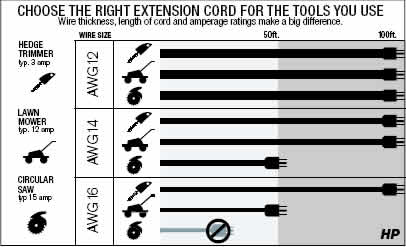October 2001
Outdoors, electrical extension cords are part of the backyard landscape, powering everything from hedge trimmers to power saws to drink mixers, and even electric lawnmowers. Indoors, they're used for temporary power needs from basement to attic.
Because electrical tools and appliances have different power ratings, these rugged, weather-resistant portable cords are designed to accommodate a variety of temporary power requirements. (Note that we're not talking about extension cords for strictly light-duty indoor use.) But not all extension cords are created equal. An improperly sized extension cord can cause a tool or appliance motor to burn out if allowed to run for too long. It can also cause a dangerous situation if it overheats.

How can you prevent this from happening? First, it helps to know how much electrical current (typically rated in amperes, or amps) each electric tool requires (see chart). High-powered tools like saws and mowers use considerably more amperage, so extension cords rated to handle greater electrical loads should be used with them. Tool and appliance manuals usually specify extension cord requirements for proper operation of the equipment. Amperage ratings are also marked on the equipment itself.
But how do you know how much of an electrical load your extension cord can handle? There are two factors: cord length and thickness. The thicker the copper wire, the more electricity it can carry. However, because transmitted power diminishes over distance, longer extension cords require heavier wire to deliver the full current rating required by an appliance.
The thickness of the wire can be identified by the letters AWG followed by numbers (typically 12, 14 or 16) printed on the wire jacket. In this case, less is more - the lower the number, the thicker the wire. Heavyweight AWG 12 would be used for the most demanding operations.
Given the relatively low cost of extension cords, compared to the expense of replacing a ruined tool or appliance, consumers are urged to check the numbers and buy up. You may have one application in mind when shopping for a cord, but end up using it for more demanding applications. The wire can never be too big, but it can be too small.
Also, keep in mind that if you attach a multi-outlet device to an extension cord, allowing several tools to draw power at the same time, the current demand may exceed the amperage rating of the cord and create an unsafe condition.
To increase safety and prevent accidental shocks, some extension cords now feature inexpensive, built-in GFCI (Ground Fault Circuit Interrupter) receptacles - just like those that should be installed in your kitchen and bath. A GFCI immediately cuts off all power when it detects any current imbalance on the line.
Learn more information in our Electrical and Telecommunications sections. ![]()
